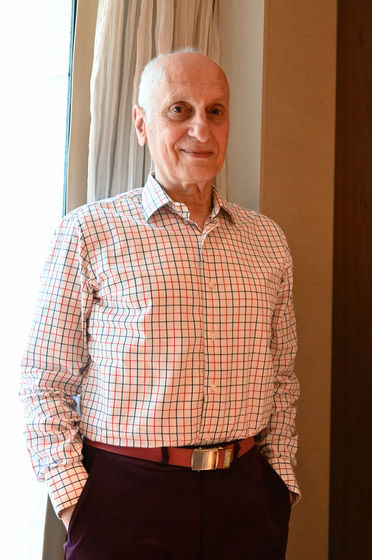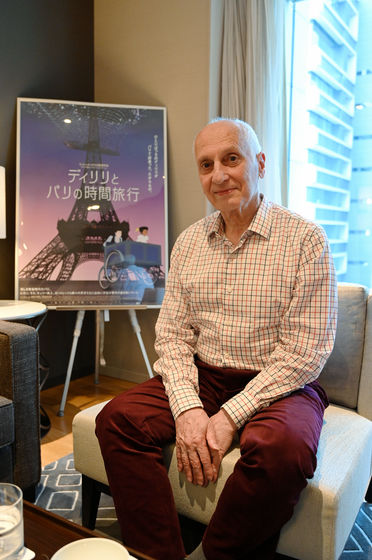Interview with Michel Ocelot of 'Dilili and Paris Time Trip', which captures beautiful Paris in a realistic movie

French anime film director
This time, I had the opportunity to ask Oslo about the work in detail, so I asked him various questions about the production and the background he was particular about.
Movie 'Dilili and Paris Time Trip' Official Site
https://child-film.com/dilili/

GIGAZINE (G):
In producing 'Dilili and Paris Time Trip', the director said, 'It's finally time to make a movie set in Paris.' Have you always thought about making a work set in Paris?
Director Michel Ocelot (hereinafter Oslo):
I didn't think about it at all. Earlier, when Director Isao Takahata told me that I could only make Japanese movies in Japan, I realized that I could only make French movies in France. Of course, when I start thinking about a story, I don't really care about country or nationality. I think of myself as a world citizen and am of interest to me anywhere in the world. I'm like a child who loves sweets, so I feel like I can eat anything, so I pick up whatever I'm interested in and eat it.
G:
I see (laughs)
Oslo:
That's why I'm making works in various places around the world, such as Tibet, Japan, South Africa, Persia, and Lebanon, regardless of the country and place where the work is set. But France is also a very interesting country, isn't it? Besides, it was often said by everyone. 'After all, you have to shoot a movie in Paris.' That's why I finally decided to set the stage in Paris this time.
G:
You said that the idea of the movie started with sets and costumes, but did you mean that it was assembled from the visual rather than the story?
Oslo:
First of all, the issue I'm interested in right now is the global issue, which is about women or men who oppress girls. In fact, the number of women and girls dying for reasons other than war is much higher than the number of deaths in war. But just because I wanted to draw it in a movie didn't necessarily mean that I wanted to set it in Paris.
G:
That led to the 'time trip between Diriri and Paris'.
Oslo:
As you said, I started with sets and costumes. I always do research before entering a movie, but as I researched the era called ' Belle Epoque ,' I realized that it was a great era. There were men who abused women and girls in this era, but I thought that civilization would be a contrasting countermeasure against the dark problem. What's interesting about Paris is that it's not just the people who live in Paris and the genuine Parisians, but also the talented people and geniuses from all over the world.
G:
Just by looking at the trailer, many celebrities such as Gustave Eiffel and Pablo Picasso have appeared.
Dillili and Paris Time Trip-YouTube
Oslo:
so. Not limited to one field, excellent people of various genres, such as artists, scientists, and literary figures, gathered in Paris. Another interesting aspect of the Belle Epoque is that it was a time when women were finally beginning to claim their 'rights.' You have come to insist on 'living your own life.' At that time, there was no law to promote it.
G:
That's right…….
Oslo:
With this trend, female university students were born for the first time in this era. It was also during this period that female taxi drivers, university professors, female doctors and female attorneys were born. The great female scientist Marie Curie was also born during this period. As a creator, I don't want to hurt people or make them uncomfortable. Just pushing the dark story forward will destroy the audience, so instead, in the form of counterpoint, it is an era when wonderfully talented women have begun to play an active role. I made it clear in 'Time Travel'. I'm glad I was able to draw such a story.
G:
So that's it.
Oslo:
France is not a closed country, but a very open country that accepts foreigners from all over the world. Foreigners naturally gather in Paris. Of course, Japanese people came, but there weren't many famous Japanese people in the Belle Epoque era. Tsuguharu Foujita, who later became a popular painter, was also a Japanese in the days of Bell Epoch, but when he was young, he dressed like a Frenchman and didn't feel the 'Japanese identity' (laughs). However, even if there were not many famous Japanese people, 'Japonisme' was extremely prosperous. In fact, this work also incorporates the famous Ukiyo-e as 'Japonisme'.
G:
I missed it ... where is it?
Oslo:
One is Hiroshige Utagawa's ' Hundred Views of Edo, Daihashi Atake no Yudachi ', and the other is Katsushika Hokusai. It's secretly put in, so please find it (laughs)
G:
You can't take your eyes off the background. I would like to ask you about the background, but the background of this work is used by processing the photo. The director said, 'I can't think of reproducing it on a graphic palette because Paris is wonderful.' How did you decide to process the photo and use it as a background?
Oslo:
For example, a poor poet wrote a poem in Paris. It's not good if the poem gives Paris a worse image than it really is. I don't want to be such a bad poet. Of course, I myself try to talk about reality through my work, and some of them are abominable reality that abuses women and girls. However, the intention is not only to draw such a dark side, but also to draw a good side and a civilized side that fits the reality so that you will feel better when you look at it. As for Paris, 'I have a wonderful reality in front of me, so let's use it as a photograph without processing it.'
G:
I see, i see. Because reality is more beautiful than anything else.
Oslo:
That's it. There is a beautiful reality, so I take a picture of it and put it in a movie realistically. If you draw it as a graphic, the accuracy will be lower than in reality. The celebrities appearing in this work are all real people, and there are still pictures, so I was inspired by that and made them into characters. In the history of movies in the world, there aren't many movies with so many celebrities (laughs).
G:
(Laughs) In terms of the 'bright side,' the main character, Diriri, had a cute little gesture, which also contributed to the brightness of the work.
Oslo:
Thank you
G:
Earlier, the director said in an interview, 'I have nothing to be careful about when drawing children.' In this work, the message 'All the production staff of this movie thought of their daughters' was displayed on the end roll, but was there anything that you took in from familiar girls?
Oslo:
I draw the original picture, but it is the animator's job to draw the gesture as a video, so if there is something that leads to the cuteness of the girls, it is thanks to the animator. There are great animators in the French anime industry, and there are also specialized schools. Especially since there are female animators, there may be some gestures that can be made because of the animations made by those women. The animators I worked with this time did more than I asked for, even if I didn't say 'Please do this', so this kind of work was completed. For example, the adorable gesture that Diriri shows in a scene where a picture of a ship and a picture of a ship are 'I cherish this' is a movement created by a female animator. The idea of a female animator is to 'take care' by tilting your head a little and tending to look down. What's more, I was surprised to be able to do it with the keyboard and PC screen instead of hand-drawing.
G:
Regarding Diriri, it is said that a cute movement was created by digital drawing. The director has a very long career, working from paper-cutting animation to hand-painting, and thus working on digital drawing works, but isn't it difficult to get used to it?
Oslo:
No, it wasn't difficult at all. I can't operate a PC like an animator myself, but I share the same language with the animators. However, although there are good points in terms of technology, there are also drawbacks, and those drawbacks are disappointing ...
G:
Are the drawbacks obvious to the audience?
Oslo:
No, it's a flaw on the part of human beings who handle technology, so it's something that the audience doesn't notice. And it's not the fault of others, but the fault of myself. For example, when shooting a paper cutout with a camera, if something goes wrong, you have to start from 0. It means that human beings who cannot be perfect from the beginning lack the skills to operate the equipment. Paper-cutting can be expressed very simply, but there is also an advanced technique of rotating the paper-cutting 360 degrees by making it a little more complicated. A 3D movie gives a three-dimensional effect, and you can freely create it with 3D software. But in terms of fun, the former was more fun.
G:
(Lol)
Oslo:
Whether it's paper-cutting or drawing, I think it's an artist's work in the sense of 'doing it with your own hands.' However, when working on a PC, it looks like a bureaucrat rather than an artist (laughs), and 3D itself is expensive, isn't it? In my next work, I will go back to paper-cutting again. However, I'm thinking of paper-cutting that incorporates digital rather than completely manual work.
G:
You are already thinking about the next one. Is it expensive for 3D animation because there are many work processes?
Oslo:
It's simply because it costs labor. In 3D animation, there is no almighty person who is familiar with the whole process, and since it is a division of labor system that 'that is this person, this is this person', an expert is required for each work. For example, long hair swaying in the wind, or a woman's muffler or shawl fluttering in the wind. When I try to draw, I quantify the elasticity of the shawl cloth and the friction when the shawl hits my body, and input it to make it look like it is fluttering well on the screen. But if you make a mistake in this number by just a few percent, it's as if the plastic is moving, not the shawl.
G:
You run into a different problem than hand-painting.
Oslo:
It's difficult to reach what I envisioned just by playing with the numbers, so in that case I decided to go back to the beginning and make it hand-painted. For example, the water in the fountain at Place de la Concorde was much easier to hand-paint than in 3D. Other than that, the movement of fine water like splashing in the scene of the underground lake where Emma Calve comes out was also hand-painted. That is much faster.
G:
Well, if you think that part is rather hand-painted ... Not to mention the story and the play of the character, it is a work that you can not take your eyes off the background and the spray. Thank you very much.
The latest film directed by Michel Ocelot, 'Dilili and Paris Time Trip,' will be released on Saturday, August 24, 2019 at

Related Posts:







